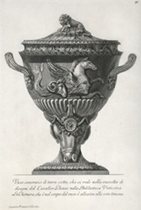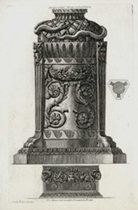Giovanni Battista Piranesi was one of the finest etchers of all time. His technical mastery rendered his strong copperplate etchings of classical antiquities brilliantly three dimensional. Piranesi combined technical perspective from his studies of architecture, archaeology, classical sculpture and mythology, with artistic flamboyance developed from his experience with Venetian theatrical stage design.
The son of a stonemason, Italian artist Giovanni Battista Piranesi (1720-1778) was born near Venice, and was introduced to the Latin language and ancient civilizations by his brother who was a Carthusian monk. He received practical training in structural and hydraulic engineering from his maternal uncle Matteo Lucchesi, who as Magistrato delle Acque of the Venetian waterworks, was an engineer specializing in excavation and drainage.
Piranesi the architect. 
By the age of 20 Piranesi was in Rome on the staff of the Venetian ambassador, Marco Foscarini. Inspired by the grand architecture of imperial Rome, Giovanni Battista aspired to become an architect, but had difficulty securing commissions in this field. His only important architectural work came much later, between 1764 and 1766, when he designed and restored the monastery church of the Priory of the Knights of Malta, Santa Maria del Priorato on the Aventine Hill in Rome, and also built the piazza in front of the church. Piranesi’s fine stonemasonry incorporated appropriate heraldry, military and naval references, as well as motifs from ancient Rome and Etruria. The pièce de résistance was his elaborately sculpted main altar.
Venetian Pope Clement XIII recognized Piranesi’s contribution to the glory of the church, and in 1765 conferred upon him the Papal Order of Chivalry known as the Order of the Golden Spur (or Order of the Golden Militia). This Papal Order of Chivalry granted him the right to sign his work Cav. G.B. Piranesi or Cavaliere Gio. Batta. Piranesi.
 Architect or Artist?
Architect or Artist?
In Venice most of the time between 1743 and 1747, Giambattista returned to central Rome and set up his own workshop on Via del Corso, where he began creating his series of large etchings of Vedute di Roma (Views of Rome). Piranesi meticulously measured and recorded ancient Roman buildings, aqueducts, and archaeological sites. He then drew and etched them onto copper in his own distinctive style, resulting in Piranesi being considered by many to be the first great artist of Romanticism. This series of etchings brought him not only fame, but also his election as honorary Fellow of the Society of Antiquaries in London in 1757. Piranesi continued to produce his dramatic plates for this series until the year he died.
In 1761 Giovanni Battista Piranesi joined the Rome Academy of Saint Luke, Accademia di San Luca, an association of artists, which included painters, sculptors and architects. The Academy’s purpose was to elevate the status of all artists above that of 'mere craftsmen'. Piranesi set up his own printing facility and published his own etchings for Delle magnificenze ed architettura de Romani (The magnificence of Roman architecture), which he used to support the Italian point of view that Roman art had derived from the Etruscans not the Greeks (as had been the opinion of French and British scholars of the day).
Stonemason and Etcher.
At his workshop, Piranesi not only creatively restored Roman archaeological discoveries, he also designed and built amazing artefacts in stone, combining fantastical themes with his recordings of discovered antiquities. As wealthy Europeans travelled to Rome, they commissioned stonemasonry from the Piranesi workshop. Exquisite Piranesi etchings of this work are still enjoyed today. Piranesi was not only fascinated by Roman antiquities, his designs also reflected Baroque and Rococo style, earlier Etruscan, Greek and Egyptian design, and mythological symbolism.
As his father had done, Giovanni Battista taught his craft to his children. He instructed his sons Francesco and Pietro, and his daughter Laura, in etching, engraving and architectural principles, but only Francesco excelled.




Piranesi Vases and Urns.
Francesco Piranesi (1758-1810), assisted his father in his prosperous business, and in the imaginative restoration and creation of ornamental antiquities – in particular of the urns and pedestals for which Piranesi gained international renown. Francesco assisted his father in some etchings for Vasi, Candelabri, Cippi y Sarcofagi Tripodi Lucerne ed Ornamenti Antichi disegnati ed incise dal Cav. Gio. Batt. Piranesi (Vases, Candelabri, Gravestone Pillars and Sarcofagi, Tripods, Lamps and Antique Ornaments designed and etched by Cavalier Giovanni Battista Piranesi) – Piranesi’s best known work of Roman antiquities. They were first issued as individual etchings published in Rome between 1773 and 1778.
Piranesi judiciously dedicated many of these plates to clients who had commissioned them, and he inscribed some plates with information about the original discovery and the present location of the antiquities. Piranesi's consumate skill as an etcher is shown in his vases.
Piranesi's bold inventiveness, extraordinary imagination, and masterful graphic technique established a new benchmark in 18th century printmaking. The light and shade of Piranesi’s etchings show wonderful depth, particularly in illustrating his relief carvings, with a clarity of line that is quite rare, even in the finest of early engravers’ and etchers’ work.
Piranesi Vases have been avidly collected since their creation over 300 years ago. Such has been their popularity, that reproductions are now available of some of his wonderful vases.
Original etchings are available on this website at Antique Prints/Classical-Design.
Heritage Editions reproductions images that were produced from a few of the rare original etchings are also available on this website at Heritage-Editions/Classical-Design.